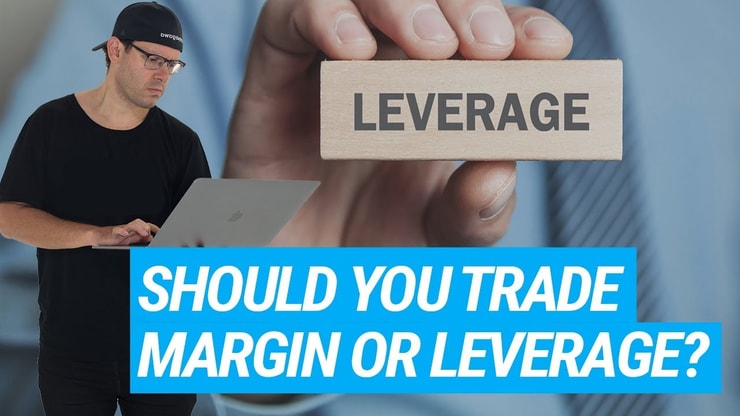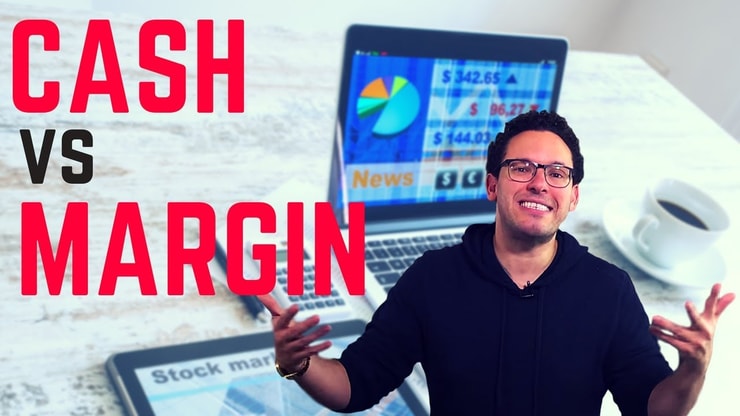Buying on margin is a financial strategy where a trader borrows money from their broker to purchase stocks or other financial instruments. This strategy allows the investor to leverage their position, potentially increasing their returns if the market performs favorably.
Here’s the disclaimer — while buying on margin can amplify gains, it can also amplify losses. It’s associated with speculation and subject to strict laws for good reason!
Before purchasing or investing in a company with margin, there’s a lot of information to know…
It isn’t just about business performance or how “cheap” a contract is. Margin trades usually have more risk than reward.
This article will get into margin trading examples, bank and broker rules, and the way to avoid going into debt on a dumb bet. Let’s get into the content!
Table of Contents
Definition of Buying on Margin

Buying on margin is a practice where an investor borrows money from a broker to purchase securities. The purchased securities serve as collateral for the loan. The investor can leverage their existing assets to buy more than they could with just their available cash, potentially amplifying their gains. However, this practice also comes with increased risk.
It’s important to grasp the differences between margin and cash accounts. Each comes with its own set of advantages and disadvantages, and the choice between the two can significantly impact your trading strategy. To delve deeper into this topic, check out this comprehensive guide on Margin Accounts vs Cash Accounts. It provides a detailed comparison to help you make an informed decision.
What Are the Benefits of Buying on Margin?
One of the main benefits of buying on margin is the potential for increased returns. By borrowing money to purchase more shares than you could with just your available cash, you can potentially earn more if the stocks increase in value.
Additionally, margin accounts often offer lower interest rates compared to other types of loans, such as mortgages. This is because the securities in your brokerage account serve as collateral for the loan, reducing the risk for the broker.
Finally, buying on margin can provide you with financial flexibility, allowing you to take advantage of investment opportunities without having to sell off existing assets.
An Opportunity to Leverage Assets
Buying on margin allows investors to leverage their existing assets to make larger investments. This can potentially lead to higher returns if the investment performs well.
Investors can also profit from declines in share prices when buying on margin. This is done through a practice known as short selling, where an investor borrows shares and sells them, hoping to buy them back later at a lower price.
Ability to Diversify Your Concentrated Portfolio
Buying on margin can also help investors diversify their portfolio. By borrowing money to invest, they can spread their investments across a wider range of assets.
A Hassle-Free Line of Credit
Margin accounts can also act as a hassle-free line of credit. Investors can borrow against the value of the securities in their account without needing to apply for a traditional loan.
Low-Interest Rates
Interest rates on margin loans are often lower than those on personal loans or credit cards, making it a cost-effective way to borrow money for investments.
Flexibility in Repayments
Unlike traditional loans, there’s no set repayment schedule for a margin loan. As long as the investor maintains the required level of equity in their account, they can repay the loan at their own pace.
What Are the Risks with Buying on Margin?

While buying on margin can offer potential benefits, it also comes with significant risks. The most notable risk is the potential for substantial losses. If the securities you purchased on margin decrease in value, you could lose more than your initial investment. Additionally, if the equity in your account falls below the broker’s maintenance margin requirement, you may face a margin call, requiring you to deposit additional funds or sell securities to cover the shortfall. If you’re unable to meet the margin call, the broker has the right to sell your securities without consulting you, potentially resulting in significant losses.
Inability to Meet the Margin Call
If the value of the securities in a margin account falls below a certain level, the broker may issue a margin call, requiring the investor to deposit more funds. If the investor can’t meet the margin call, the broker can sell their securities to cover the loan.
Leverage Risk
While leverage can amplify gains, it can also magnify losses. If the investor’s investments perform poorly, they could end up losing more than their initial investment.
All You Need to Know About Margin Loan

A margin loan is a type of loan that allows you to borrow money to invest in securities, using the securities in your brokerage account as collateral. The amount you can borrow is typically a percentage of the value of the securities in your account, as determined by the broker’s margin requirements. Margin loans offer the potential for increased investment returns, but they also come with increased risk, including the risk of a margin call. It’s important to carefully review the terms and conditions of a margin loan, including the interest rates and margin requirements, before deciding to borrow.
What Is a Margin Loan?
A margin loan is a loan taken by an investor from their broker, using the securities in their margin account as collateral.
How Does a Margin Loan Work?
When an investor takes a margin loan, they agree to repay the loan with interest. If the value of the securities in their account falls below a certain level, the broker may issue a margin call, requiring the investor to deposit more funds or sell some of their securities.
Advantages and Disadvantages of Obtaining a Margin Loan
The main advantage of a margin loan is the ability to leverage existing assets to make larger investments. However, the risk of a margin call and the potential for large losses are significant disadvantages.
You should also pay attention to risk — diversifying your investment portfolio is one way to mitigate these risks. Some traders also invest in a Roth IRA, which offers tax advantages and can be an excellent tool for retirement savings.
To learn more, check out this guide on the Best Roth IRA Accounts. It provides a detailed overview of the top Roth IRA accounts.
Brokerage Firms and Trading Platforms

There are many brokerage firms and trading platforms that offer margin trading. These platforms vary in terms of the services and features they offer, such as the types of securities you can trade, the margin requirements, the interest rates on margin loans, and the tools and resources available for research and analysis.
Some platforms may also offer additional features, such as robo-advisory services or advanced trading tools. When choosing a platform for margin trading, it’s important to consider these factors and read reviews from other users to ensure the platform meets your needs.
When it comes to trading platforms, StocksToTrade is first on my list. It’s a powerful trading platform that integrates with most major brokers. I helped to design it, which means it has all the trading indicators, news sources, and stock screening capabilities that traders like me look for in a platform.
Grab your 14-day StocksToTrade trial today — it’s only $7!
Types of Brokerage Firms and Trading Platforms Available for Buying on Margin
There are many types of brokerage firms and trading platforms that offer margin trading, including traditional brokers, online brokers, and robo-advisors. Each type of broker has its own advantages and disadvantages, and the best choice depends on the investor’s individual needs and circumstances.
Features Offered by Different Brokerage Firms and Trading Platforms
Different brokers offer different features, including various types of investment products, research tools, educational resources, and customer service options. Some brokers also offer advanced trading platforms with sophisticated charting tools and analytics.
Finding the Right Brokerage Firm or Trading Platform for Your Needs
When choosing a brokerage firm or trading platform for margin trading, it’s important to consider factors such as fees, interest rates, minimum balance requirements, and the broker’s reputation. It’s also a good idea to read reviews and compare several options before making a decision.
Initial Investment Requirements
The initial investment required to open a margin account varies between brokers, but it’s typically a minimum of $2,000, as per the guidelines set by the Financial Industry Regulatory Authority (FINRA). This initial investment serves as collateral for the margin loan. It’s important to note that while this initial investment allows you to start trading on margin, you’ll need to maintain a certain level of equity in your account to continue trading and avoid a margin call. This is known as the maintenance margin requirement, and it’s typically a percentage of the total value of the securities purchased on margin.
Margin accounts can be a powerful tool for traders, but they aren’t the only option for growing your wealth. Individual Retirement Accounts (IRAs), for instance, offer a different approach to investment, focusing on long-term growth and retirement savings. If you’re interested in diversifying your investment strategies, take a look at this list of the Best IRA Accounts. It provides a thorough analysis of top IRA accounts to consider.
Minimum Initial Investment Required to Buy on Margin
The minimum initial investment required to buy on margin varies between brokers, but it’s typically $2,000 or more. This is a regulatory requirement set by the Financial Industry Regulatory Authority (FINRA).
Calculating the Amount Needed to Invest in Order to Buy on Margin
To calculate the amount needed to invest in order to buy on margin, you need to know the price of the securities you want to buy and the margin requirement set by your broker. The margin requirement is the percentage of the total purchase price that you must pay with your own money.
How to Buy on Margin
Buying on margin involves opening a margin account with a broker, depositing the required initial investment, and then borrowing money from the broker to buy securities. It’s important to understand the risks involved and to monitor your investments closely to avoid a margin call.
Who Should Buy on Margin?
Buying on margin is best suited for experienced traders who understand the risks involved and are comfortable with the potential for large losses. It’s not recommended for beginners or for those who can’t afford to lose more than their initial investment.
What Is a Margin Call?
A margin call is a demand from a broker for an investor to deposit more money or securities into their margin account when the value of the securities falls below a certain level. If the investor can’t meet the margin call, the broker can sell their securities to cover the loan.
Key Takeaways

Buying on margin allows investors to leverage their assets to make larger investments, potentially leading to higher returns. However, it also comes with increased risk, including the potential for large losses and the risk of a margin call. It’s important to understand these risks and to carefully consider your own risk tolerance before deciding to buy on margin.
It isn’t a silver bullet for your trading plan — but margin is one of many topics you should learn as part of your trading education!
Trading isn’t rocket science. It’s a skill you build and work on like any other. Trading has changed my life, and I think this way of life should be open to more people…
I’ve built my Trading Challenge to pass on the things I had to learn for myself. It’s the kind of community that I wish I had when I was starting out.
We don’t accept everyone. If you’re up for the challenge — I want to hear from you.
Apply to the Trading Challenge here.
Trading is a battlefield. The more knowledge you have, the better prepared you’ll be.
Do you use margin in your trading strategy? Let me know in the comments — I love hearing from my readers!





Leave a reply